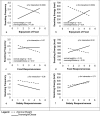Interrelationships of child appetite, weight and snacking among Hispanic preschoolers
- PMID: 27780312
- PMCID: PMC5763377
- DOI: 10.1111/ijpo.12186
Interrelationships of child appetite, weight and snacking among Hispanic preschoolers
Abstract
Background: Snacking among US preschoolers has increased in recent decades, raising questions about whether snacking contributes to dietary excess.
Objectives: This research aimed to characterize snacking contributions to dietary excess and to evaluate associations with appetite and weight among preschool-aged children.
Methods: This study is a cross-sectional, observational study of 187 Hispanic low-income preschoolers. Three 24-h dietary recalls were used to assess snacking frequency and parameters of dietary excess including energy, saturated fat, trans fats and added sugars. Parental reports of child satiety responsiveness, food responsiveness, and enjoyment of food were obtained. Child height and weight were measured.
Results: Children consumed 28% (395 kcal) of daily energy from snacks eaten at 2.3 ± 1.0 occasions per day. Greater snacking frequency was associated with greater daily intakes of energy (p < 0.05) and added sugars (p < 0.001). Among overweight/obese children, higher enjoyment of food was associated with more frequent snacking and greater energy intake from snacks (p = 0.01). Inverse associations of enjoyment of food with snacking frequency and energy intake were seen among normal weight children (p < 0.05).
Conclusions: More frequent snacking among low-income Hispanic preschoolers may contribute to excessive intakes of energy and added sugars, particularly among overweight/obese children with greater motivation to eat.
Keywords: Appetite; child; snacking; weight.
© 2016 The Authors. Pediatric Obesity published by John Wiley & Sons Ltd on behalf of World Obesity Federation.
Figures

References
-
- U.S. Department of Agirculture . Meal and snack pattern B. 2016. [WWW document]. URL http://www.choosemyplate.gov/downloads/PatternB1000cals.pdf.
-
- American Academy of Pediatrics . Committee on nutrition In: Kleinman RE. (ed.). Pediatric Nutrition Handbook. University of Michigan: American Academy of Pediatrics: Elk Grove, IL, 2004.
-
- Agricultural Research Service . Table 25: Snacks: percentages of selected nutrients contributed by foods eaten at snack occasions, by gender and age, in the United States, 2009–2010. What We Eat in America, NHANES 2009–2010. Washington, D.C.: US Department of Agriculture; 2012.
-
- Cross MB, Hallett AM, Ledoux TA, O'Connor DP, Hughes SO. Effects of children's self‐regulation of eating on parental feeding practices and child weight. Appetite 2014; 81: 76–83. - PubMed
Publication types
MeSH terms
Grants and funding
LinkOut - more resources
Full Text Sources
Other Literature Sources
Medical

